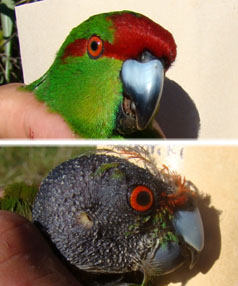 DEVASTATING EFFECTS: A healthy red-fronted parakeet provides sharp contrast to a bird severely affected by the beak and feather virus.Scientists are worried a virulent disease affecting parakeets is more widespread than thought. Recent work among native red-fronted parakeets on Little Barrier Island has confirmed their worst fears.
DEVASTATING EFFECTS: A healthy red-fronted parakeet provides sharp contrast to a bird severely affected by the beak and feather virus.Scientists are worried a virulent disease affecting parakeets is more widespread than thought. Recent work among native red-fronted parakeets on Little Barrier Island has confirmed their worst fears.
“We estimate in a sample of 54 parakeets about 25 per cent have the virus, we don't know what is the real percentage in the whole population," says scientist Luis Ortiz-Catedral
Beak and feather disease causes birds to lose their feathers, develop beak deformities, and weakens their immune systems.
The disease makes them susceptible to infection, and there is no cure.
 A bird balding with the virusScientists say it is vital to try to stop the disease from getting into critically endangered native bird populations such as the kakapo, which has a population of just over 120.
A bird balding with the virusScientists say it is vital to try to stop the disease from getting into critically endangered native bird populations such as the kakapo, which has a population of just over 120.
“Because birds can be the carriers such as exotic rosellas to places where kakapo might be likely to move they could be exposed to the disease” Mr Ortiz-Catedral says.
All kakapo will be tested for the virus over the next few months, although so far none have shown any sign of the disease.
To avoid transmitting the disease, scientists are calling for owners of exotic parakeets to make sure they do not escape into the wild.
 A team from the Auckland Zoo examined 53 kakariki on Tiritiri Matangi, “Direct contact with other birds is a very very good way of spreading the disease around,” says Dr Arvind Varsani of Canterbury University.
A team from the Auckland Zoo examined 53 kakariki on Tiritiri Matangi, “Direct contact with other birds is a very very good way of spreading the disease around,” says Dr Arvind Varsani of Canterbury University.
Dr Virsani says New Zealand’s native parakeets need to be watched closely; those at risk include the South Island high country kea, and also the orange-fronted parakeet which has a population of between four and five hundred.
“There are no vaccines at the moment but there are researchers in the United States and Australia looking at this development,” says Mr Varsani.
More studies will be done on Little Barrier Island later this month as scientists work out the best way to stop the disease from spreading.